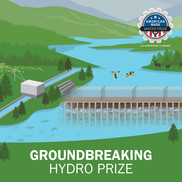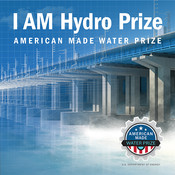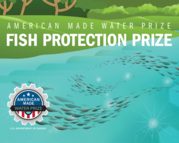|
What’s Inside: This edition of Water Wire highlights prize and competition activities, tool updates, STEM spotlights, and additional hot topics for the month.
Continue to follow the Water Wire and emails from WPTO for the latest news and updates from the office. Reach out to WaterPowerTechnologiesOffice@ee.doe.gov with any inquiries or suggestions.
Estimated read time: 7.5 minutes
Hydropower Day
On National Hydropower Day, a Memorandum of Understanding (MOU) for Hydropower was signed by the U.S. Department of Energy Water Power Technologies Office (WPTO), the Department of the Interior Bureau of Reclamation, and the U.S. Army Corps of Engineers. Building on a previous collaboration among the agencies, this MOU will help meet the nation’s needs for reliable, affordable, and environmentally sustainable hydropower by strengthening a long-term working relationship, prioritizing similar goals, and aligning ongoing and future renewable energy development efforts.
Prize and Competition Updates
|
For roughly 100 years, hydropower has been a primary source of renewable energy generation throughout the world—now providing 80 gigawatts of installed capacity in the United States alone. Hydropower will be a source of renewable energy for years to come; however, substantial roadblocks to its continued expansion include construction of foundations for new hydropower development.
To incentivize innovation in hydropower development, WPTO, in collaboration with the National Renewable Energy Laboratory (NREL) and Oak Ridge National Laboratory (ORNL), plans to launch the Groundbreaking Hydro Prize in the coming months.
|
|
 |
This prize is partially guided by the newly released ORNL report, Hydropower Geotechnical Foundations: Current Practice and Innovation Opportunities for Low-Head Applications, which examines how the cost, time, and risk of hydropower foundation design and construction can stall the forward momentum of new projects.
On June 30, WPTO launched the Innovations in Advanced Manufacturing for Hydropower (I AM Hydro) Prize, a new competition designed to leverage the power of advanced manufacturing to address some of hydropower’s most critical challenges. The I AM Hydro Prize will provide up to $250,000—split among up to 16 winners—to develop creative applications that use advanced manufacturing to lower the cost and improve the performance of hydropower components and facilities. The prize is accepting submissions until September 30. |
|
 |
The $700,000 Fish Protection prize cast a wide net, bringing together industry, academia, entrepreneurs, and everyone in between, to catalyze new solutions, designs, and strategies to protect fish from water infrastructure, such as water diversions and pipes, and intakes at hydropower dams. In May, WPTO announced nine winners of the CONCEPT Stage, the first of the three-stage prize, who will present their ideas at a pitch contest hosted by the American Fisheries Society (AFS) at their Virtual Annual Meeting September 15–16. |
|
 |
Back to top
Tool Updates
Navigating the red tape surrounding the complex hydropower regulatory process can be daunting. To assist both interested community members and experienced hydropower developers, NREL led a Hydropower Regulatory and Permitting Information Desktop (RAPID) Toolkit webinar on July 9. The event gave stakeholders a sneak peek into recent toolkit updates and newly released tools and publications that can shed light on the various federal, state, local, and tribal requirements for hydropower project development. The toolkit is a one-stop shop for essential permitting information, allowing developers to navigate the complex system of federal and state hydropower regulations and permits with ease.
MHKiT, an open-source marine renewable energy (MRE) software solution developed in Python/MATLAB, includes modules for data processing, quality control, visualization, and resource assessment. A newly released version of the software—MHKiT v0.2.0—includes new power and loads modules and is publicly available on GitHub. For more information about MHKiT, refer to the online documentation. NREL, Pacific Northwest National Laboratory (PNNL), and Sandia National Laboratories (Sandia) collaborated to develop MHKit.
WEC-Sim v4.1 has been released, adding new features like passive yaw and updated WEC-Sim applications to this open-source code for simulating wave energy converters. Developed in MATLAB/SIMULINK, with the ability to model devices that comprise rigid bodies, joints, power take-off systems, and mooring systems, WEC-Sim is publicly available on GitHub. More information about WEC-Sim is available from the software’s online documentation. Funded by WPTO, WEC-Sim is a collaboration between NREL and Sandia.
Back to top
STEM Spotlight
WPTO and NREL recently launched Science, Technology, Engineering, and Math (STEM) education portals for water power technologies. Offering a vast repository of open-source resources for students and educators, the STEM Hydropower Portal and STEM Marine Renewable Energy Portal can help educators and students better understand water power technologies and their potential, as well as future career opportunities within the industry.
Water power technologies are poised to play an important role in meeting future U.S. energy demands. Hydropower is capable of providing reliability and resiliency services to our evolving grid, and marine energy is well-suited to support activities at sea or along coastlines where energy is otherwise unreliable or costly. The future of water power, however, requires new talent and innovation. Visit the portals to learn more.
If your coastal community’s drinking water infrastructure were suddenly compromised, by, for example, a natural disaster, do you have any idea how you’d create potable water? The finalists of the Waves to Water Prize DESIGN Stage do! They have some great ideas and are working to turn them into reality.
During the DESIGN phase, teams were asked to prove they had the technical capacity and a sufficient plan to turn their concept into a functional prototype. Recently, WPTO announced the 17 DESIGN Stage finalists chosen to build their proof-of-concept systems in a subsequent stage. Among the 17 winners, four teams come from academic institutions and include both students and faculty. Meet the collegiate teams.
Back to top
In Case You Missed It
The deadline for the Request for Information (RFI) for stakeholder input on the Energy Storage Grand Challenge Draft Roadmap is August 31, 2020.
The Draft Roadmap, released by DOE on July 14, 2020, outlines a Department-wide strategy to accelerate innovation across a range of storage technologies based on three concepts: Innovate Here, Make Here, Deploy Everywhere. The Draft Roadmap includes five tracks:
- The Technology Development Track will focus DOE’s ongoing and future energy storage R&D around user centric goals and long-term leadership.
- The Manufacturing and Supply Chain Track will develop technologies, approaches, and strategies for U.S. manufacturing that support and strengthen U.S. leadership in innovation and continued at-scale manufacturing.
- The Technology Transition Track will work to ensure that DOE’s R&D transitions to domestic markets through field validation, public private partnerships, bankable business model development, and the dissemination of high quality market data.
- The Policy and Valuation Track will provide data, tools, and analysis to support policy decisions and maximize the value of energy storage.
- The Workforce Development Track will educate the workforce, who can then research develop, design, manufacture, and operate energy storage systems.
Launched by U.S. Energy Secretary Dan Brouillette in January 2020, the Energy Storage Grand Challenge (ESGC) is a comprehensive program to accelerate the development, commercialization, and utilization of next-generation energy storage.
Earlier this year, WPTO-funded researchers at Sandia successfully tested the Floating Oscillating Surge Wave Energy Converter (FOSWEC) at Oregon State University’s Directional Wave Basin Facility. Sandia had previously developed control design and testing methods for wave energy converters (WECs) based on experiments with a different device called the WaveBot. The goal for testing the FOSWEC was to confirm whether these same methods would work well for the FOSWEC, and therefore be applicable to the wide range of wave energy converter designs currently being considered. Learn more about the device in this video.
Oceans cover 71% of the planet—but 80% those waters remain unmapped and rarely monitored due to limitations with existing ocean observing technologies, including energy constraints. In the first stage of the Powering the Blue Economy™: Ocean Observing Prize, participants undertook a 90-day mission to DISCOVER new ways to help overcome energy constraints that stand in the way of effective and comprehensive ocean observation. NREL highlighted four competition winners back in May and the remaining winners this month. Learn more on the prize competition page.
PNNL Scientists Selected as Marine Energy Journal Guest Editors
The Journal of Marine Science and Engineering has selected two PNNL marine energy researchers— Zhaoqing Yang and Lenaïg Hemery—to serve as guest editors.
Yang, PNNL chief scientist for coastal ocean modeling, edited the special issue, Wave and Tidal Energy Resource Characterization and Environment Interactions, which focuses on recent marine energy-related studies and features articles by eight PNNL researchers.
Hemery, a PNNL marine energy specialist, will serve as a topic editor of special issues related to the field of marine science. In this role, she will suggest topics for new special issues and oversee the editorial process.
Back to top
|